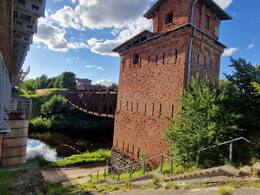Kurmaičiai Bridge: a place of war ghosts
In the Mažeikiai district, in Kurmaičiai, the railway bridge over the Venta River, built in 1904-1905, became not only a strategically important object during the war, but also a place about which mysterious stories about the ghosts of soldiers and inexplicable phenomena circulate.
The old bridge, the remains of which can be seen under the new one built a decade ago, bears witness to the intense hostilities - the walls are riddled with bullets, four-story turrets with machine gun nests remain. "I have no words to describe what was happening there in the evening before midnight. Through the window we saw some kind of image that was difficult to see. Then someone threw a stone at me... It seemed like something was strangling me. I started to gasp for air, tears started to flow," says one of the witnesses. Another visitor recalls: "I heard, like my friends around me, scared when we saw soldiers marching like shadows. I still don't understand what happened there, but it seemed very real." The area, now called the "Valley of Ghosts", is associated with the massacres and torture of World War II. "I don't really believe in myths, but I believe I don't feel comfortable there. When walking there, you can find crosses made of branches or sticks. They say that this is how people protected themselves from ghosts," says a local resident.
Related timeline
Related objects
A Set of Railway Bridge Structures in Kurmaičiai
In Kurmaičiai (near Mažeikiai), a railway bridge is located over the River Venta. This metal bridge with two masonry watchtowers has been abandoned for many years. The traffic is organised on the new bridge built next to the old one. The first wooden bridge over the River Venta was built in 1871–1873 to carry important cargo for Tsarist Russia. In 1904–1905, the bridge was replaced by a stronger wooden bridge, which was blown up in 1915 (during the First World War). In 1918, the bridge was rebuilt as a metal structure. The new bridge became one of the longest and widest single-track bridges of its time, measuring 70 m in length. Because of its strategic importance, the bridge was heavily guarded during World War II. Stone watchtowers with bullet marks stand on both sides of the river, bearing evidence of shelling that once took place. In 1941, German soldiers are said to have shot approximately 4,000 people in the vicinity of the bridge. The bridge was also carefully guarded during the second Soviet occupation. The bridge that is in use today was built over the rubble of the first bridge that was blown up. Now you can see bridge structures from as many as three different periods in one place.






